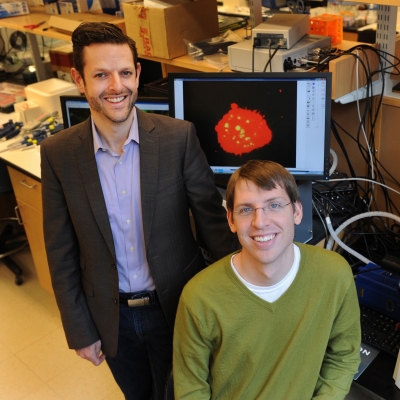 Harvard stem cells scientists at Brigham and Women’s Hospital and MIT can now engineer cells that are more easily controlled following transplantation, potentially making cell therapies, hundreds of which are currently in clinical trials across the United States, more functional and efficient.
Harvard stem cells scientists at Brigham and Women’s Hospital and MIT can now engineer cells that are more easily controlled following transplantation, potentially making cell therapies, hundreds of which are currently in clinical trials across the United States, more functional and efficient.
Associate Professor Jeffrey Karp, PhD, and James Ankrum, PhD, demonstrate in this month’s issue of Nature Protocols how to load cells with microparticles that provide the cells cues for how they should behave over the course of days or weeks as the particles degrade.
“Regardless of where the cell is in the body, it’s going to be receiving its cues from the inside,” said Karp, a Harvard Stem Cell Institute Principal Faculty member at Brigham and Women’s Hospital. “This is a completely different strategy than the current method of placing cells onto drug-doped microcarriers or scaffolds, which is limiting because the cells need to remain in close proximity to those materials in order to function. Also these types of materials are too large to be infused into the bloodstream.”
Cells are relatively simple to control in a Petri dish. The right molecules or drugs, if internalized by a cell, can change its behavior; such as inducing a stem cell to differentiate or correcting a defect in a cancer cell. This level of control is lost after transplantation as cells typically behave according to environmental cues in the recipient’s body. Karp’s strategy, dubbed particle engineering, corrects this problem by turning cells into pre-programmable units. The internalized particles stably remain inside the transplanted cell and tell it exactly how to act, whether the cell is needed to release anti-inflammatory factors or regenerate lost tissue.
“Once those particles are internalized into the cells, which can take on the order of 6-24 hours, we can deliver the transplant immediately or even cryopreserve the cells,” Karp said. “When the cells are thawed at the patient’s bedside, they can be administered and the agents will start to be released inside the cells to control differentiation, immune modulation or matrix production, for example.”
It could take more than a decade for this type of cell therapy to be a common medical practice, but to speed up the pace of research, Karp published the Nature Protocols study to encourage others in the scientific community to apply the technique to their fields. The paper shows the range of different cell types that can be particle engineered, including stem cells, immune cells, and pancreatic cells.
"With this versatile platform, which leveraged Harvard and MIT experts in drug delivery, cell engineering, and biology, we've demonstrated the ability to track cells in the body, control stem cell differentiation, and even change the way cells interact with immune cells,” said Ankrum, a former graduate student in Karp’s laboratory. “We're excited to see what applications other researchers will imagine using this platform.”
The National Institutes of Health, a Prostate Cancer Foundation Challenge Award, and a Hugh Hampton Young Memorial Scholarship, supported this research.
Cited: Engineering cells with intracellular agent-loaded microparticles to control cell phenotype. Nature Protocols. January 9, 2014 [Epub ahead of print]
Photo: Harvard Associate Professor Jeffrey Karp, PhD (left), and James Ankrum, PhD (right). (Credit: Brigham and Women's Hospital)
